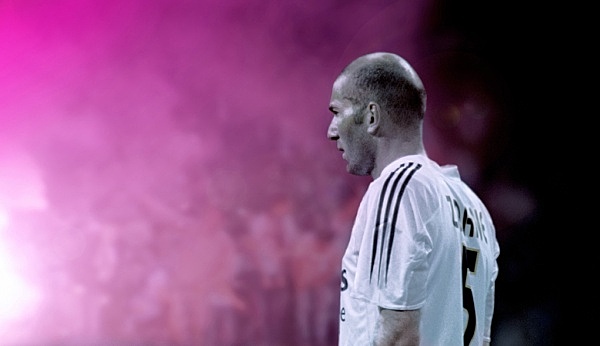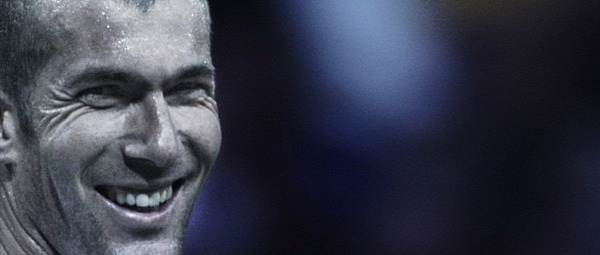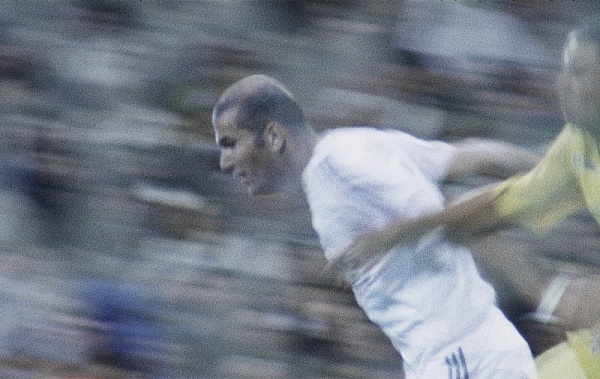The Eternal Moment
Carl Atiya Swanson digs into the film "Zidane: A 21st Century Portrait" - screening for the MIA's "The Sports Show" through May 13 - and unearths death-defying creativity in the soccer-player's game and in the power of the right shared moment in time.



FORTY-ONE MINUTES INTO THE FOOTBALL ASSOCIATION CHALLENGE (FA) CUP quarterfinal match between Bolton Wanderers and Tottenham Hotspur, at White Hart Lane on Saturday, March 17, 2012, Bolton midfielder Fabrice Muamba collapsed. He was away from the ball at the time, away from the view of the cameras. He simply lay on the ground, face down. Once the crowd noticed him lying prone, a gasping ripple made its way through the stadium. The cameras panned over him, captured his unresponsiveness to medical attention, and then quickly cut away to shocked fans, players beginning to cry and pray. As before Muamba’s fall, the billboards continued to flash “To Dare is To Do” and “The Game is about the Glory;” commentators spoke obliquely about the situation, filtering back to viewers what was happening on the pitch: that a defibrillator was being brought out, that Muamba was not moving, that there were no details on his condition yet, that the fans had begun chanting his name – “Fabrice, Fabrice, Fabrice” — as if a group incantation could will the player back to life. Everyone seemed convinced they’d just seen a man die in front of them.
The match was abandoned four minutes after Muamba collapsed. His heart, which had stopped, was restarted 78 minutes after he fell, at the London Chest Hospital. In that time, he was physically dead and yet very much alive in the blaze of television coverage, Facebook and Twitter posts, and prayers for his recovery that poured in across the world. Those moments in time — four minutes, 41 minutes, 78 minutes — were all of a sudden at once instantaneous and timeless, their significance bestowed and multiplied by the number of observers turned participants, by the gravity of the experience.
On Saturday, April 23, 2005, a day like many other days, another football match was played. In the Spanish league, Villareal visited Real Madrid at the Estadio Santiago Bernabéu. Along with the usual television crews broadcasting the match, there were 17 additional cameras at the stadium that day, all trained on Real Madrid’s temperamental and brilliant midfielder, Zinedine Zidane. At that point — just a league season and an infamous World Cup head-butt away from ending his professional playing career — Zidane was already a legend. He had been a part of the French team that won the 1998 World Cup and 2000 European Championship; Zidane had won the FIFA World Player of the Year three times; he helped Real Madrid win the Champions League in 2002 and the Spanish league in 2003. His was physically aggressive play balanced by impeccable technical control and an ability to create, out of a glint of nothing, moments of breathtaking creativity on the field. If you’d say that football is just running with a ball, then, in the same way, you’d have to say painting is just pigment on a canvas. Zidane — he was Caravaggio in cleats.
For the run of his involvement in that 2005 match, those 17 extra cameras tracked Zidane for footage which was then used to create the film, Zidane: A 21st Century Portrait by Douglas Gordon and Philippe Parreno — currently on view at the Minneapolis Institute of Arts as part of the exhibition The Sports Show. It’s displayed there in a double-screen installation format for only the second time in the United States, and shown in a darkened room with speakers set all around. The film is immersive. That it covers a match, ostensibly in real time, invites the notion of an Aristotelian tragedy, everything unfolding in a unity of time, place, and action, but the experience of actually watching the work is at odds with such linear conception. With jump cuts, multiple camera angles, and slow-motion, Gordon and Parreno fracture the film and break up the rhythm of the game. The soundtrack — lush, deep, and pulsing, by the Scottish band Mogwai — builds ominously and is cut with the roars and wails of the fans, and then drops out entirely for moments of silence, or feet brushing the grass, a television announcer, or a barked order, all of it breaking up and directing us away from a singular, linear temporal flow.
Heightening the amorphous sense of time, the MIA is showing the film on a loop, so the viewer’s point of entry is never set — you may come into the match midway through, at the very beginning, or at the end. Without a match clock present, the viewer’s experience of pacing is variable, too: a couple of minutes can feel like an eternity along with the pace of the game, or like a flash, depending on what’s happening in the moment when the film picks up. As Zidane himself puts it, in the subtitles that occasionally pop up on the screen, “The game, the event, is not necessarily experienced or remembered in ‘real time.’ My memories of the game and events are fragmented.” The experience of watching Zidane, as an experience, then, is a faithful aesthetic recreation of the function of memory itself, lifelike in its incompleteness, in its fracture.
And within the aesthetic framework of memory’s elided record, the sights and sounds of the film give it an undeniable sense of drama. In an interview with Columbia University’s C-Lab, Parreno, one of the co-directors of Zidane, acknowledged that even with the complicating effect of the film’s construction, the intrinsic pull of a classic narrative structure is itself enough to draw the audience in: “A character begins to be built…you start to engage with him just by spending time looking at him. The stories you start to tell are your stories, and you begin to produce your variations.”
So, what is there to see in Zidane, particularly for a viewer without any contextual knowledge of the sport, of the man? A man running; a man standing, sweating, shouting the occasional “Vamos, vamos;” a man staring down the ball.
Sitting in the installation one day, a gallery-goer leaned over to his son and pointed out Zidane’s balding top, remarking, “He looks like Saint Francis.” At the MIA on Thursday, March 1, Simon Critchley, chair of philosophy at the New School for Social Research in New York, gave a lecture entitled “Soccer: Not a Matter of Life and Death. Much More Important Than That.” In the lecture, he brought up the Heinrich von Kleist essay, “On the Marionette Theatre,” in which the essayist and an actor discuss the practice of art, and the latter concludes: “Grace appears most purely in that human form which either has no consciousness or an infinite consciousness. That is, in the puppet or in the god.”
______________________________________________________
We watch Zidane watching, measuring, and then in a burst of understanding, moving. Even a viewer without a passion for football or knowledge of the player is vulnerable to the mesmerizing effect of seeing the human body in motion, to the magnetic pull of his skill and unsurpassed grace in play.
______________________________________________________
Even to the uninitiated, it’s clear: here is a man at work in a specialized and strange way, creating opportunities for others on the field — moving, waiting, timing everything. It’s in his eyes, as they squint and flicker from under the shadow of his heavy brow. Gordon and Parreno zoom in on those eyes over and over again, underlining Zidane’s constant search for understanding the totality of the game, for that infinite consciousness. We watch Zidane watching, measuring, and then in a burst of understanding, moving. Even a viewer without a passion for football or knowledge of the player is vulnerable to the mesmerizing effect of seeing the human body in motion; by virtue of Zidane’s own skill, coupled with the focus given him by the film, he is magnetic. Zidane may not be a saint, but he certainly had a grace in play that seemed to pass human understanding.
The search for the infinite consciousness of the game is a visibly weighty quest; throughout the film, Zidane presents a grim, stern face. In fact, he smiles only twice — the first time, in resignation, reacting to a penalty awarded against Real Madrid in the 31st minute that set them back 1-0. (Even after a burst of speed in the 62nd minute takes him past the Villareal defenders, to slot an impossibly tight shot across the face of goal for the prolific Brazilian striker Ronaldo to head in at the last possible instant to level it 1-1 — Zidane doesn’t crack a celebratory smile.) Midway through the film, Zidane’s subtitles appear; he notes: “Sometimes you get to the stadium and you feel like it has already been decided, like the script has been written.” That sentiment makes his second, sustained smile, all the more powerful. Real Madrid has gone up 2-1, and in the closing minutes of the game, Villareal is throwing all they can at the Madrid goal. As defender Roberto Carlos jokes to calm the nerves, Zidane breaks his concentration and laughs a stretched, exhausted laugh, with wolfish teeth spread across his wrinkled face. There is, again, resignation, but it’s mixed with a little joy, too, even relaxation. Five minutes later, some scuffling occurs at the end of the pitch, and in a rush of protective anger, Zidane races over and gets embroiled in the middle of it. He gets in too close, pushes. David Beckham has to pull him off; Zidane is shown a red card and ejected from the game.
Brian Philips writes in his essay, “Soccer’s Heavy Boredom,” published online at Grantland: “In sports, pure chaos is boring. Soccer gives players more chaos to contend with than any other major sport.So there’s something uniquely thrilling about the moments when they manage to impose their own order on it.” Or, as Critchley put it in his volume, The Book of Dead Philosophers, “… of course this is stupidly obvious, death is the limit in relation to which life is lived. Accepting one’s mortality, then, means accepting one’s limitation.”
That imposition of order is the spark that binds sports to art: both seek the creation of something that extends past ordinary mortal chaos into immortal memory, acknowledging the limitation and then pushing it out as far as it will go. In art, those are the moments which isolate that physicality and elevate it; sport makes it the ongoing practice. From Michelangelo’s muscle-bound torsos to Muybridge’s photographic series of motion to Chris Burden getting himself shot in the arm, sport and art run parallel in defiance of death.
Living in defiance of fate is a hallmark of the tragic hero. Iterations of this same story, of the against-all-odds hero, appear repeatedly in our shared mythologies — in the solitary artist and the compressed violence of a man on a mission. For this hero in this kind of story, death is preferable to chaos. Zidane’s accomplishment, his art, is that he managed to impose order upon his own chaos for so long — that is his ‘infinite consciousness’ and grace. The tragedy is when he lets his control go, breaks the rules and reacts in a way that takes him out of the chaos of the game permanently. His penalty is that he loses any further opportunity to create, his red card a symbolic death — even as the game goes on and his team-mates keep playing, a man down.
Emi Fontana, Mike Kelley’s former lover, remarked in a tribute he contributed for Frieze Magazine after Kelley’s suicide, “In his work, Mike was constantly rearranging chaos into orderly cosmologies. His ultimate gesture — dramatic, but carefully composed and orchestrated — left us with a sense of irreparable loss and emptiness, filled with a beautiful and eternal light.” Mike Kelley’s actual death did the same as Zidane’s red card – it removed him from ordinary mortal chaos, and also from the opportunity to create.
And still, no one stands or falls alone. Zidane and Zidane could not exist without the litany of other great players on the pitch — Beckham, Roberto Carlos, Ronaldo, Raúl, Iker Casillas, Diego Forlán, and others — or without the artists Gordon and Parreno, without the fans in the stands, without us. At the beginning of the match and at half-time, Gordon and Parreno remind us of that fact with a montage of news clips: a puppeteer with a Bob Marley act; a 48-hour marathon reading of Don Quixote; nine dead in Najaf, Iraq, one of the survivors wearing Zidane’s number-5 jersey; Voyager recording plasmawave sounds of the solar wind; news of the death of actor Sir John Mills, who is shown in a television studio holding up a picture of a woman and admonishing us to look, look at a human face. That montage, although one could make the argument that it weakens the singular focus of the film, is critical to put it into a context of the rest of the world, all these things happening contemporaneously.
Zidane is a portrait of ourselves in the 21st century, careening between puppets, gods and our own fragile humanity and its defiance of death. The final quote of the film suggests that “magic is sometimes very close to nothing at all.” So, too, is life. We seek out the stories that might bind us together, searching for the familiar in the face of a star football player as he tries to understand and control his game, his world. We make art, go to plays and galleries and concerts to stand and sit and sing with others, creating a togetherness that holds the mortal limit at bay, for one protracted moment. We play games together, remember our own litany of names, and the fracture of time. We multiply that death-defying effect with our numbers, willing that simply our being together, in the same time and place, can create that ‘magic of order that is so close to nothing at all.’ For four minutes, 41 minutes, 78 minutes, a lifetime — we pray for Muamba.
______________________________________________________
Related exhibition details:
You can see screenings of Zidane: A 21st Century Portrait, directed by Douglas Gordon & Philippe Parreno, at The Sports Show exhibition in the Minneapolis Institute of Arts through May 13.
______________________________________________________
About the author: Carl Atiya Swanson is a multi-disciplinary artist living in Minneapolis. He is a graduate of the University of Southern California School of Fine Art and is currently pursuing an MBA in Nonprofit Administration and Entrepreneurship at the University of St. Thomas. He blogs on arts & culture at CakeIn15 and is a member of the theater company Savage Umbrella. His first full-length script, Care Enough, is being produced by Savage Umbrella and will run at the nimbus theater June 1-16.